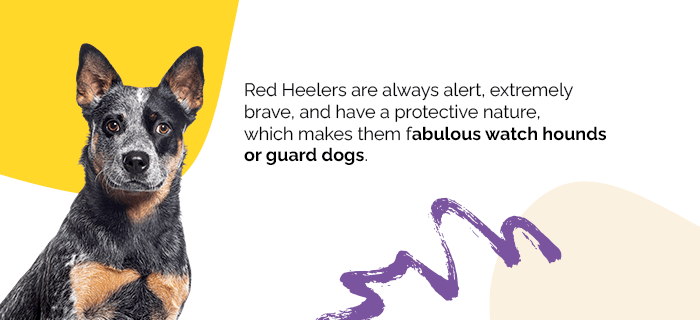
Origins of Red Heeler
The Red Heeler is a cross between a native Dingo and a Collie or other herding dog. The breed was developed in Australia in the 1840s and quickly became popular among ranchers impressed with their strength, toughness, stamina, and work ethic. These qualities made the breed capable of dealing with the Australian outback's high temperatures and rough land. Despite the heat, they can run for a long time without tiring, and their muscular legs and rigid feet can handle the rocky terrain. These competent cattle dogs earned their name "Heeler" from their strange yet effective herding method of nipping cattle at their heels. The "Red" part of their name is because most have red speckled coats. Today, the Australian Shepherd Red Heeler is still a common sight on farms and ranches across Australia, the USA, and other countries. However, many Red Heelers have swapped their working life for a family one, entering the homes of pet owners worldwide. The price of a Red Heeler dog can vary significantly, ranging from $500 to $2500. However, their price is often based on their genetics, parents' health, and breeding conditions, so bear this in mind when looking for a Red Cattle Dog. Choosing the cheapest one is often not a good idea.What Does A Red Heeler Look Like?
Red Heelers are medium-sized dogs weighing between 30 and 45 pounds and standing 17 to 20 inches tall. A Red Heeler puppy will typically reach its full size around 18 months. Red Cattle dogs have athletic and compact builds, with their legs and neck being the most muscular body parts. They also have broad heads with a strong jaw and pointy, wide-set ears that sit high, similar to a German Shepherd. Red Heelers have weather-resistant double coats, consisting of a thick, densely-packed undercoat and straight outer hairs. Interestingly, a Red Heeler puppy is born with white fur. However, as they grow, they develop brown hair, and by adults, their coats usually have a red speckled patterning. This patterning occurs when the brown hairs grow evenly through the original white coat. They can also have dark brown or tan markings on their face or body.Personality and Behavior of Red Heeler's

The Australian Shepherd Red Heeler is a high-energy breed. So if they are not used as working dogs, they require lots of exercise and ideally need an enclosed outdoor space where they can run around and let off steam. Red Heelers are also very intelligent and hardworking, so they get bored quickly if they do not have enough to do. Therefore, they thrive in an environment where they can help out somehow. In addition, they need an owner who has time for play and training to keep their minds stimulated. Despite being bred as working dogs, they are naturally very playful with humans, including children. Moreover, they show uncanny loyalty, which is why many families choose them as a companion for the home. Red Heelers are always alert, extremely brave, and have a protective nature, which makes them fabulous watch hounds or guard dogs. Plus, they don't tend to bark much, so unlike some other breeds, if you hear a Heeler barking, you know something is likely up. The downside to their protective nature is that they can become overprotective and hostile to strangers if not properly socialized when young. So, if you're getting a Red Heeler puppy, familiarize them with people of all ages and other animals immediately. This breed is more independent than some other breeds, so separation anxiety is not much of a concern. As long as they have plenty to do, they typically do fine when left alone. It's easy to tell if they are bored, though, as they will start destroying things in the home.
How to Train Red Heeler's
Because of their high intelligence and hardworking nature, training a Red Heeler dog is not difficult. However, they require a lot of training to keep them happy and healthy physically and mentally. Because of this, Heelers are best suited to experienced dog owners. When training the Red Cattle dog, choose mentally stimulating exercises like obedience and agility training. This will engage their mind and give them a job, allowing them to fulfill their desire to work hard and please their owner. Red Heelers also make excellent participants in games like Fetch and Frisbee as they feel like they have a purpose and are needed. And like with most breeds, Heelers respond best to positive reinforcement training. One important thing you should train your Heeler to do is to run off-leash with a good recall. This will make exercising them much more manageable. Also, note that Red Heelers can develop the tendency to nip at small children or animals to try to herd them. Thus, teaching them not to do this is essential if living in a home with kids or other pets.Grooming and Maintaining a Red Heeler's Coat
In general, Red Heelers are relatively low-maintenance dogs. They shed excessively twice a year, but shedding is minimal for the rest of the year. Therefore, most of the time, brushing them twice a week is sufficient. However, once you see it is shedding season, you'll need to brush them daily or every other day to keep it under control. You typically don't need to bathe your Heeler unless they have rolled in mud or are particularly smelly. Although Red Heelers spend a large amount of their time running around outside, nail trimming should still be a part of their grooming and maintenance routine. They likely won't need their nails trimmed often, but you should aim to check every four weeks. You can use a dog nail grinder or clippers; whichever you choose, socialize them with the tool from an early age to make the process easier for you both. Lastly, don't forget to brush their teeth regularly to prevent build-up of decay and keep gum disease at bay.
Common Health Issues
Red Heeler dogs have a relatively good lifespan of 12 and 15 years. Still, like most breeds, there are several genetic conditions that they may be susceptible to, including:- Retinal atrophy and rod-cone degeneration - This is when the eye's retina deteriorates (usually later in life) and can result in blindness.
- Deafness - Red Heelers carry recessive piebald alleles (the gene responsible for producing white in the coat and skin), which is linked to congenital hereditary deafness.
- Arthritis
- Hip dysplasia
- Elbow dysplasia
